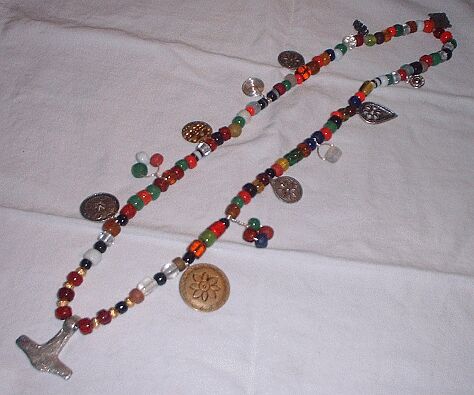|
|
|
|
|
|
|

|
The particular elements of this necklace are as follows: Style: c. 860 CE, as found in Hon, Norway, and currently in the Universitetets Oldsaksamling, Oslo Pendants: pewter Thor's hammer (central), brass disks, pewter "coins", silver wire spiral, pewter grotesque, silver bead loops, etc. Beads: glass, foil-lined glass, "gold" with granulation (beads chosen to match those in the archeological recreation as closely as possible) Cord: waxed linen
General Discussion and Background
Styles: 1) relatively even beads with a similar diameter, sometimes varying in length or shape, often color-grouped (but this might be the archeologist's re-stringing) 2) graduated beads, from small on ends to large in center, often millefiori; probably worn around the neck? 3) necklaces of relatively even beads with multiple metal (gold/silver/unspecified) pendants; probably worn between brooches? (otherwise the pendants in the back are hidden) There was a hoard containing a pendant necklace (and many gold coins and rings) found in Hon, Norway, that is believed to have been left around 860 C.E. This is the pendant necklace most commonly pictured and contains a wide variety of colored glass and possibly semi-precious stone beads, bead loops, and metal pendants. The current re-working of it by the archeologists also includes some gold granulated/filigree metal beads that had originally been left separate from the necklace. There are two examples of pendant necklaces usually pictured together: (1) mostly red carnelian and rock crystal, with several bead loops and metal pieces, and (2) yellow glass beads with green, black, crystal, and what look like pearls, with one metal disk and one bead loop.
Pendants: Pendants were also made of silver wire strung with one or more beads in a loop. The wire was twisted together into a shaft (the length varies), then the ends of wire were coiled to make a tube for stringing the loop.
Beads: The foil beads are very interesting: a layer of silver foil is applied around a glass core and topped with an additional layer of glass. Sometimes the topping layer is yellow glass to make the silver foil appear gold. Many Viking beads that look to be plain metallic are really these glass foil beads. I haven't seen any examples of gold or silver foil applied to the surface of glass beads as is often done in modern lampwork. Books talk about "shell" beads, but the example I've seen has uncut cowrie shells used as pendants on a necklace between glass beads; so shaped beads made out of shell material may not be appropriate. Beads were an easy trade good to carry, and many of the Viking finds include beads from Russia, Byzantium, Rome, the Near East, and India, as well as more locally made beads. The most common shapes are round beads, and short to medium length cylinders. Sometimes round beads are melon-ridged or lobed. Sometimes cylinders widen into a ridge around the center. Occasionally there are thin disks and longer barrel cylinders. Sometimes the beads have large facets, especially in a shape like a cube or a rectangle with the corners cut off. Often seen patterns in glass beads are: spots and eyes; waves and combed patterns; sharp and soft zigzags, crossing zigzags; horizontal or vertical stripes in cylindrical beads; checkerboard and patchwork millefiori round beads. But plain glass beads were the most common.
Cording:
Books & Info on Pendant/Treasure Necklaces: Fitzhugh, William W., & Elisabeth I. Ward (eds.). Vikings: The North Atlantic Saga (Smithsonian Institution Press, 2000). Many good pictures, with the recently re-worked Hon necklace. Graham-Campbell, James, and Dafydd Kidd. The Vikings. (NY: Metropolitan Museum of Art, 1980). Good pictures (bad illustrations) and the earlier re-working of the Hon necklace. Lady's Maid Jewels: History: sells recreation jewelry, but includes a picture of the carnelian and yellow pendant necklaces. Lothene Experimental Archeology: Jewellery: discussion and pictures, including a very elaborate treasure necklace that seems to be a compilation of reproduction metal items rather than an actual find. Persdotter, Viktoria. "Reconstructing Female Costume of the Viking Age": illustration of pendant necklace strung between brooches. Viking Answer Lady: Beads: pictures of both the Hon and carnelian necklaces; includes "How to Construct a Treasure Necklace." Wareham Forge makes reproduction pewter; includes picture of their recreation of a pendant necklace. Wilson, David M. (ed.) The Northern World. (NY: Harry N. Abrams, Inc., 1980). Also good pictures and the earlier re-working of the Hon necklace.
Other Information on Viking Beads: Early Materials Forum: Bead Making in Viking York
Frojel (Sweden) History of the Glass Bead (Lady Sveva Lucciola) Illuminating History: Through the Eyes of Media (Finds from Finland): Studio Photographs Jorvik Viking Centre: Coppergate Dig
The Kaupang Investigation (Norway) Manx National Heritage: Buried Boats and Bizarre Rites Timeless Beads (Lady Rixende de Rouen) Vikingerne i England. London: Anglo-Danish Viking Project, 1981. York Archaeology Center: Secrets Beneath Your Feet: Viking York (Jorvik): Dress |
|
|
|
To contact Carol Hanson by e-mail click here. |
Home |
Usage |
Forums |
Articles |
Patterns |
Graphics |
Extras |
Contact Us